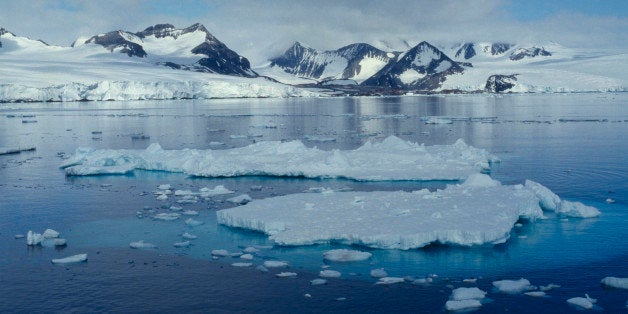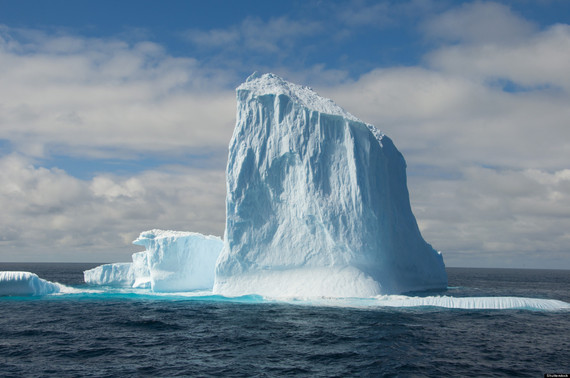
Authored by Mario Molina, V. Ramanathan, and Durwood Zaelke
Bad news can be paralyzing, and that's a problem when it comes to climate change. The steady drumbeat of bad news can numb us. We've recently learned that a large part of the West Antarctica ice sheet is disintegrating and cannot be stopped, with ten feet or more of sea-level rise now inevitable. More recently we learned the bad news from the U.S. climate assessment, confirming that climate impacts have moved "firmly into the present," with costs mounting quickly -- more than $100 billion in the U.S. alone in 2012 -- and a near certainty that things will get worse quickly. At the global level, the Intergovernmental Panel on Climate Change sent the same message.
In the face of this news, the U.S. risks moving from climate denial to climate despair--that citizens can do little to stop impacts, that government doesn't have the political courage needed to adequately address the problem, and that industry genius will falter and not develop the technologies to solve climate change in time to avoid the worst impacts.
To avoid this it would be extremely helpful to implement fast mitigation that shows near-term improvements in the climate, on a timescale relevant to politicians' short election cycles, and that can demonstrably reduce impacts and the risk of passing dangerous tipping points that set off self-amplifying warming that feeds on itself.
Can any strategy produce such fast results? To answer this we need to review the underlying climate science, to understand that there are two main levers we can pull to slow climate warming. The first lever is the one that reduces the carbon dioxide emitted when we burn from fossil fuels like coal, oil, and gas. To insure long-term climate stability we need to pull this lever, now, as hard as possible, promoting energy efficiency, low carbon fuels, and clean energy sources. But we also need to understand that pulling back the carbon dioxide lever will produce climate cooling very slowly: by mid-century an aggressive effort to reduce carbon dioxide can avoid 0.1° Celsius of warming, out of an expected 2° Celsius or more of warming by 2050 under business as usual.
We also need to pull back the lever to reduce the short-lived climate pollutants. These pollutants include black carbon (soot) air pollution, tropospheric ozone (the principal component of smog), methane, and several HFCs, which are factory-made gases used in air conditioning and refrigeration. Pulling this lever to cut the short-lived climate pollutants can avoid 0.6 ° Celsius of warming by mid-century, six times more than the carbon dioxide lever can produce. At the end of the century, the avoided warming from cutting the short-lived climate pollutants is 1.5° Celsius compared to 1.1° Celsius for carbon dioxide. Both strategies are essential at this point.
These numbers are from sophisticated climate models, but still have uncertainty. Yet there is no uncertainty about the speed these strategies can produce their results. Black carbon stays for only a matter of weeks, and methane and most HFCs last only for a decade and a half. In contrast, a quarter of carbon dioxide lasts essentially forever -- five hundred years to thousands of years.
President Obama's climate strategy presents a solid effort to address both carbon dioxide and the short-lived climate pollutants, in the U.S., and globally. This includes efforts to increase clean renewable energy, standards to improve mileage for autos and to replace some of the HFCs used as refrigerants in auto air conditioners, restrictions on soot emissions from heavy-duty trucks, buses, and vans, restrictions on methane, and restrictions on carbon dioxide from new power plants and proposed restrictions on existing power plants.
As a result of these and similar efforts, U.S. greenhouse gas emissions fell by 3.4% in 2012, their lowest levels since 1994. Yet emissions of HFCs continued to grow, up 41% since 1990, making HFCs the fastest growing greenhouse gases in the U.S., and in many other countries.
The president also is leading the global effort to reduce short-lived climate pollutants. This includes the Paris-based Climate and Clean Air Coalition to Reduce Short-Lived Climate Pollutants, which the U.S. launched two years ago and now has grown to nearly ninety partners, including countries from all levels of economic development. It also includes the president's effort to build the consensus needed to phase down HFCs under the Montreal Protocol, widely regarded as the most effective and efficient global environmental treaty ever created. The president has won support from the leading economies in the G7/8 and the G20, as well as with China's president, to use the Montreal Protocol to phase down HFCs. The U.S. also helped put fast action to reduce short-lived climate pollutants on the UN Secretary-General's agenda for the heads of State climate summit in New York in September.
Success cutting the short-lived climate pollutants can cut the rate of global warming in half for several decades -- indeed, it may be the only strategy that can provide such fast relief. It also produces powerful collateral benefits, including avoiding many of the seven million deaths caused by air pollution every year, while cutting crop loses.
Success reducing all of the four short-lived climate pollutants will build momentum to conclude the climate treaty next year in Paris. This should start with an agreement at the Secretary-General's September climate summit to negotiate terms for an HFC phase down under the Montreal Protocol in the next 18 months. Such an HFC phase down would almost certainly be the single biggest, fastest, and most effective piece of climate mitigation available to the world in the near-term, and would open the door to fast mitigation of the other short-lived climate pollutants.
Mario Molina, who shared the Nobel Prize in Chemistry in 1995 for his work on chlorofluorocarbons in the atmosphere, teaches at the University of California, San Diego.
Veerabhadran Ramanathan is a professor of atmospheric and climate sciences at the Scripps Institution of Oceanography at the University of California, San Diego.
Durwood J. Zaelke is the founder of the Institute for Governance and Sustainable Development, and co-directs a related program at UC Santa Barbara.

